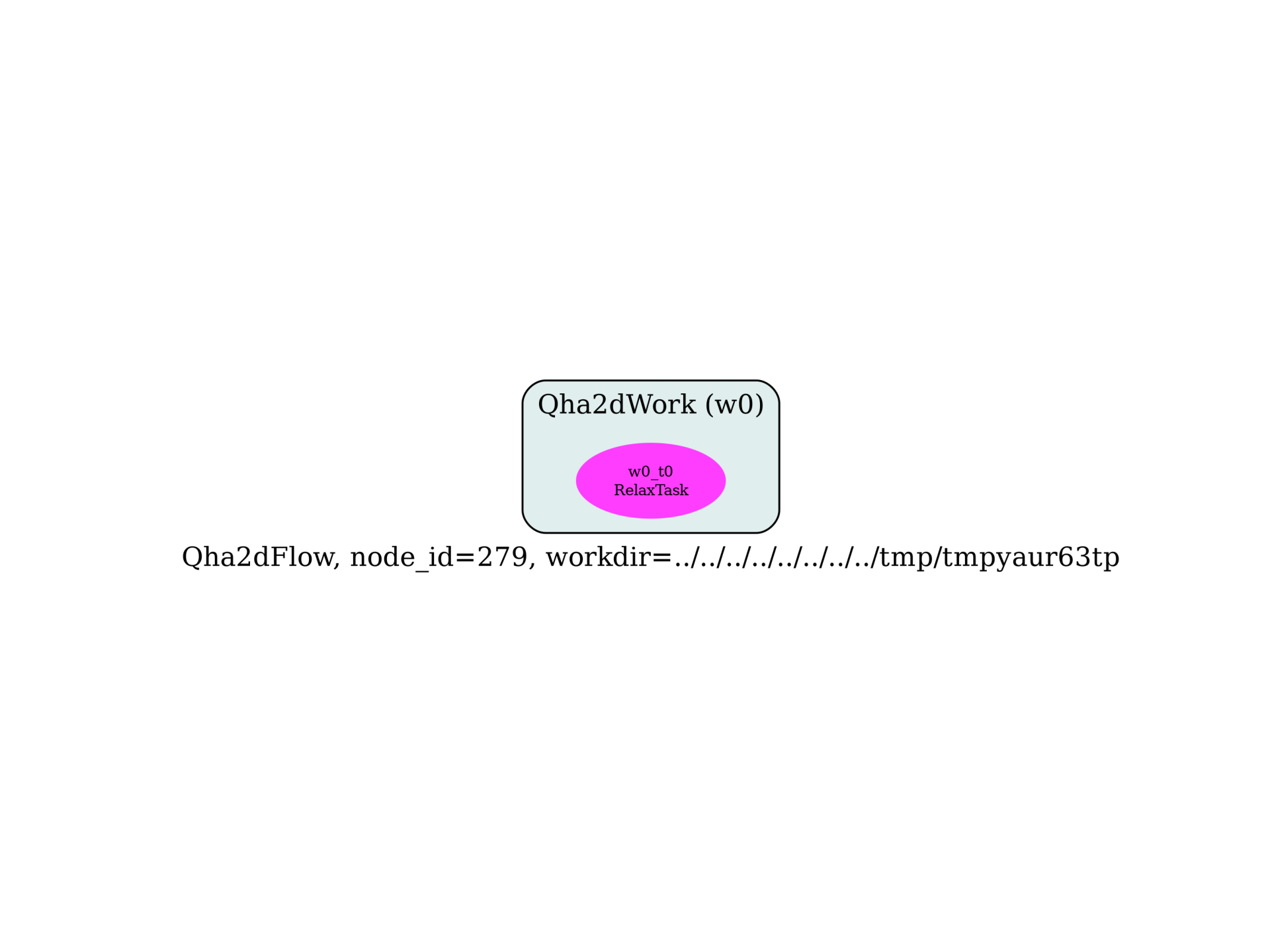Note
Go to the end to download the full example code.
Flow for QHA calculations with two DOFs
Warning: This code is still under development. This example shows to run calculations with the ZSISA quasi-harmonic approximation and two degrees of freedom.

Downloading repository from: https://github.com/PseudoDojo/ONCVPSP-PBEsol-PDv0.4/archive/refs/heads/master.zip ...
Installing ONCVPSP-PBEsol-SR-PDv0.4 in: /home/runner/.abinit/pseudos/ONCVPSP-PBEsol-SR-PDv0.4
0.00iB [00:00, ?iB/s]
787kiB [00:00, 7.55MiB/s]
1.59MiB [00:00, 7.37MiB/s]
2.36MiB [00:00, 6.71MiB/s]
3.15MiB [00:00, 7.05MiB/s]
3.87MiB [00:00, 7.00MiB/s]
4.58MiB [00:00, 6.86MiB/s]
5.27MiB [00:00, 6.79MiB/s]
6.03MiB [00:00, 6.63MiB/s]
6.84MiB [00:01, 6.70MiB/s]
7.67MiB [00:01, 6.89MiB/s]
8.42MiB [00:01, 6.73MiB/s]
9.23MiB [00:01, 6.69MiB/s]
10.1MiB [00:01, 7.02MiB/s]
10.8MiB [00:01, 6.82MiB/s]
11.6MiB [00:01, 6.99MiB/s]
12.3MiB [00:01, 6.75MiB/s]
13.1MiB [00:01, 6.98MiB/s]
13.9MiB [00:02, 7.09MiB/s]
14.6MiB [00:02, 7.14MiB/s]
15.3MiB [00:02, 7.07MiB/s]
16.0MiB [00:02, 6.96MiB/s]
16.7MiB [00:02, 6.89MiB/s]
17.5MiB [00:02, 6.42MiB/s]
18.2MiB [00:02, 6.46MiB/s]
19.0MiB [00:02, 6.80MiB/s]
19.8MiB [00:02, 7.14MiB/s]
20.6MiB [00:02, 6.94MiB/s]
21.3MiB [00:03, 6.95MiB/s]
22.1MiB [00:03, 6.71MiB/s]
23.1MiB [00:03, 7.05MiB/s]
23.9MiB [00:03, 7.38MiB/s]
24.7MiB [00:03, 7.40MiB/s]
25.5MiB [00:03, 7.22MiB/s]
26.2MiB [00:03, 6.77MiB/s]
27.1MiB [00:03, 6.84MiB/s]
27.9MiB [00:04, 6.90MiB/s]
28.8MiB [00:04, 7.05MiB/s]
29.5MiB [00:04, 7.12MiB/s]
30.4MiB [00:04, 7.12MiB/s]
31.2MiB [00:04, 7.15MiB/s]
31.9MiB [00:04, 7.27MiB/s]
32.7MiB [00:04, 7.41MiB/s]
33.5MiB [00:04, 7.30MiB/s]
34.3MiB [00:04, 7.25MiB/s]
35.0MiB [00:05, 6.78MiB/s]
35.8MiB [00:05, 6.93MiB/s]
36.6MiB [00:05, 7.01MiB/s]
37.5MiB [00:05, 6.87MiB/s]
38.3MiB [00:05, 6.99MiB/s]
39.2MiB [00:05, 7.06MiB/s]
40.0MiB [00:05, 6.97MiB/s]
41.0MiB [00:05, 7.13MiB/s]
41.6MiB [00:05, 7.02MiB/s]
Validating md5 checksums of ONCVPSP-PBEsol-SR-PDv0.4...
Checksum test: OK
Installation completed successfully in 6.98 [s]
import sys
import os
import numpy as np
import abipy.abilab as abilab
from abipy import flowtk
from abipy.flowtk.qha_2d import Qha2dFlow
def build_flow(options):
"""
Create a `Qha2dFlow` for quasi-harmonic calculations with two DOFs
"""
# Working directory (default is the name of the script with '.py' removed and "run_" replaced by "flow_")
if not options.workdir:
__file__ = os.path.join(os.getcwd(), "run_qha_2d.py")
options.workdir = os.path.basename(__file__).replace(".py", "").replace("run_", "flow_")
# Initialize structure and pseudos for ZnO.
structure = abilab.Structure.from_abistring("""
natom 4
ntypat 2
typat
1 1 2
2
znucl 30 8
xred
0.0000000000 0.0000000000 -0.0025137620
0.3333333333 0.6666666667 0.4974862380
0.0000000000 0.0000000000 0.3835201241
0.3333333333 0.6666666667 0.8835201241
acell 1.0 1.0 1.0
rprim
6.3016720624 0.0000000000 0.0000000000
-3.1508360312 5.4574080923 0.0000000000
0.0000000000 0.0000000000 9.7234377918
""")
# Use NC PBEsol pseudos from pseudodojo v0.4
from abipy.flowtk.psrepos import get_oncvpsp_pseudos
pseudos = get_oncvpsp_pseudos(xc_name="PBEsol", version="0.4")
scf_input = abilab.AbinitInput(structure, pseudos)
# Set other important variables
scf_input.set_vars(
nband=scf_input.num_valence_electrons // 2,
#nline=10,
nbdbuf=0,
nstep=100,
ecutsm=1.0,
#tolvrs=1.0e-18, # SCF stopping criterion.
tolvrs=1.0e-6, # SCF stopping criterion.
paral_kgb=0,
)
# Select k-mesh for electrons and q-mesh for phonons.
#ngkpt = [6, 6, 4]; ngqpt = [1, 1, 1]
ngkpt = [2, 2, 2]; ngqpt = [1, 1, 1]
#scf_input.set_scf_nband_semicond()
scf_input.set_kmesh(ngkpt=ngkpt, shiftk=[0, 0, 0])
bo_strains_a = [-5, 0, 5, 10, 15]
bo_strains_c = [-5, 0, 5, 10, 15]
#bo_strains_a = [0, 5, 10, 15, 20]
#bo_strains_c = [0, 5, 10, 15, 20]
# This is just for testing purposes
#bo_strains_a = [0, 5]
#bo_strains_c = [0, 5]
bo_strains_a = [0, ]
bo_strains_c = [0, 5]
bo_strains_a = np.array(bo_strains_a) / 100
bo_strains_c = np.array(bo_strains_c) / 100
bo_strains_ac = [bo_strains_a, bo_strains_c]
phdos_strains_ac = bo_strains_ac
with_becs = True
with_quad = False
#with_quad = not structure.has_zero_dynamical_quadrupoles
return Qha2dFlow.from_scf_input(options.workdir, scf_input, bo_strains_ac, phdos_strains_ac, ngqpt,
with_becs, with_quad, edos_ngkpt=None)
# This block generates the thumbnails in the Abipy gallery.
# You can safely REMOVE this part if you are using this script for production runs.
if os.getenv("READTHEDOCS", False):
__name__ = None
import tempfile
options = flowtk.build_flow_main_parser().parse_args(["-w", tempfile.mkdtemp()])
build_flow(options).graphviz_imshow()
@flowtk.flow_main
def main(options):
"""
This is our main function that will be invoked by the script.
flow_main is a decorator implementing the command line interface.
Command line args are stored in `options`.
"""
return build_flow(options)
if __name__ == "__main__":
sys.exit(main())
Total running time of the script: (0 minutes 7.186 seconds)